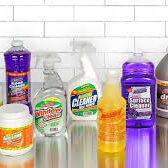Ever wondered what goes into your cleaning products and why? Manufacturers are increasingly transparent about ingredients so that you can make informed decisions. Here’s a helpful guide to common cleaning product ingredients and what they do:
Common Ingredient Functions
- Abrasive – Scrubs off dirt and grime during cleaning.
- Antimicrobial – Kills or reduces bacteria, viruses, molds, and yeasts on surfaces.
- Bittering Agent – Adds a bitter taste to discourage ingestion, enhancing safety.
- Bleach – Removes colored stains and disinfects.
- Brightener – Enhances the brightness of whites and colors in fabrics.
- Carrier – Delivers active ingredients; typically inert.
- Cleaning Agent – Loosens and dissolves soil for effective cleaning.
- Colorant – Adds color to the product for easy identification or visual appeal.
- Defoamer – Prevents excessive foam buildup.
- Denaturant – Renders alcohol unsuitable for consumption.
- Deodorizer – Eliminates or masks unpleasant odors.
- Dissolvable Film – Wraps that dissolve in water, often used in pods.
- Enzyme – Breaks down organic dirt like food, grass, or blood.
- Enzyme Stabilizer – Keeps enzymes stable until used.
- Fabric Softener – Softens fabrics and reduces static cling.
- Foam Booster – Increases foam production in sudsy products.
- Fragrance – Adds scent or neutralizes odors.
- Greasy Soil Remover – Targets oils, fats, and greasy residues.
- Laundry Cleaning Booster – Enhances detergent performance, prevents dinginess.
- Metal Surface Protector – Helps prevent corrosion on metal surfaces.
- Microbial Cleaning Agent – Uses microbes to break down grime and organic soils.
- Moisturizer – Prevents moisture loss in skin-contact products.
- Opacifier – Gives the product a creamy, non-transparent appearance.
- pH Adjuster – Alters the product’s acidity or alkalinity for performance.
- pH Stabilizer – Maintains the ideal pH level over time.
- Preservative – Prevents microbial spoilage of the product.
- Processing Aid – Helps in the manufacturing process.
- Propellant – Expels product as a spray or foam under pressure.
- Rust and Hard Water Stain Remover – Dissolves rust and mineral deposits.
- Shine Enhancer – Leaves surfaces gleaming after cleaning.
- Soil Dissolver – Breaks up and loosens dirt for easier removal.
- Stabilizer – Maintains consistency and shelf life of the product.
- Stain Repellant – Prevents future stains from clinging to surfaces.
- Static Reducer – Reduces static electricity buildup.
- Tablet Disintegrant – Helps cleaning tablets dissolve properly in water.
- Thickener – Increases the viscosity of liquids.
- Thinner – Reduces viscosity for smoother application.
- UV Light Absorber – Protects surfaces from sun damage.
- Water Softener / Soap Scum Remover – Eliminates minerals in hard water to enhance cleaning.
- Water Spot Repellant – Prevents spots from forming after rinsing.
- Wipe – The material used to apply or deliver the cleaning formula.
Understanding the roles of each ingredient in your cleaning products empowers you to choose products that are safe, effective, and suited to your specific needs. Next time you read a label, you’ll know exactly what each component is doing and why it matters. Clean smarter, not harder.








